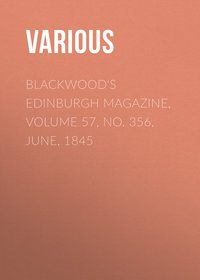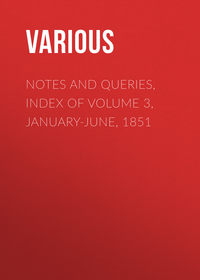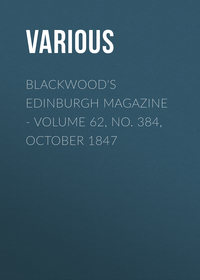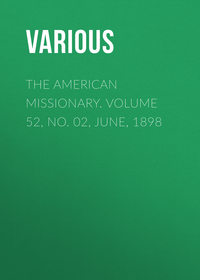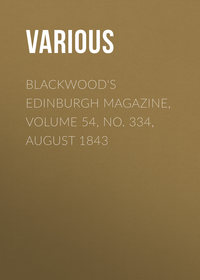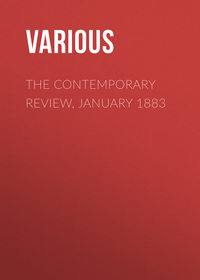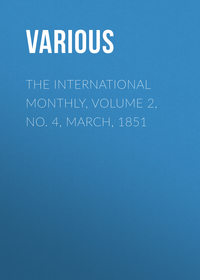 полная версия
полная версияNotes and Queries, Number 57, November 30, 1850
We see nothing like this in the agricultural districts; neither do we in those districts where the ordinary manufacturing operations themselves require the employment of the head as well as the hands and feet. With the exception, indeed, of the schoolmaster, and the exciseman, and the surveyor, there are comparatively few instances of persons whose employment was not strictly sedentary having devoted their intellectual energies to mathematics, independent of early cultivation. To them the subject was more or less professional, and their devotion to it was to be expected—indeed far more than has been realised. It is professional now to a larger and more varied class of men, and of course there is a stronger body of non-academic mathematicians now than at any former period. At the same time it may be doubted whether there be even as many really able men devoted to science purely and for its own sake in this country as there were a century ago, when science wore a more humble guise.
Combining what is here said with the masterly analysis which MR. WILKINSON has given of the books which were accessible to these men, it appears that we shall be able to form a correct view on the subject of the Lancashire geometers. Of course documentary evidence would be desirable—it would certainly be interesting too.
To such of your readers as have not seen the mathematical periodicals of that period, the materials for which were furnished by these men, it may be sufficient to state that the "NOTES AND QUERIES" is conceived in the exact spirit of those works. The chief difference, besides the usual subject-matter, consists in the greater formality and "stiffness" of those than of this; arising, however, of necessity out of the specific and rigid character of mathematical research in itself, and the more limited range of subjects that were open to discussion.
The one great defect of the researches of those men was, that they were conducted in a manner so desultory, and that the subjects themselves were often so isolated, that there can seldom be made out more than a few dislocated fragments of any one subject of inquiry whatever. Special inquiries are prosecuted with great vigour and acumen; but we look in vain for system, classification, or general principles. This, however, is not to be charged to them as a scientific vice, peculiarly:—for, in truth, it must be confessed to be a vice, not only too common, but almost universal amongst English geometers; and even in the geometry of the Greeks themselves, the great object appears to have been "problem-solving" rather than the deduction and arrangement of scientific truths. The modern French geometers have, however, broken this spell; and it is not too much too hope that we shall not be long ere we join them in the development of the systems they have already opened; and, moreover, add to the list some independent topics of our own. The chief dangers to which we are in this case exposed are, classification with incomplete data, and drawing inferences upon trust. It cannot be denied, at all events, that some of our French cotemporaries have fallen into both these errors; but the abuse of a principle is no argument for our not using it, though its existence (or even possible existence) should be a strong incentive to caution.
These remarks have taken a more general form than it is usual to give in your pages. As, however, it is probable that many of your readers may feel an interest in a general statement of a very curious intellectual phenomenon, I am not without a hope that, though so far removed from the usual topics discussed in the work, they will not be altogether unacceptable or useless.
PEN-AND-INK.MINOR NOTES
Sermon's Pills.—In Guizot's Life of Monk, Duke of Albermarle, translated and edited by the present Lord Wharncliffe, it is stated (p. 313.) that when the Duke was suffering from the diseases which afterwards proved fatal to him,
"One of his neighbours, at New Hall, formerly an officer in his army, mentioned to him certain pills said to be sovereign against the dropsy, which were sold at Bristol by one Sermon, who had also served under his orders in Scotland as a private soldier. This advice and remedy from ancient comrades, inspired the old general with more confidence than the skill of the physicians. He sent for Sermon's pills, and found himself so much recovered by them for a time, that he returned to London at the close of the summer."
Having "found," in the newspapers of the day, the following paragraphs illustrative of this passage in the great General's history, I think them sufficiently interesting "to make a Note of."
"London, July 13. 1669.—His Grace the Lord General, after a long and dangerous distemper, is (God be praised) perfectly recovered and restored to his former health, to the Great rejoycing of their Majesties and the whole court, by the assistance of one William Sermon, of Bristol, whose pills have had that excellent success as to restore him perfectly to his sleep and appetite, and wholly abate all the symptoms of his disease. Yesterday his Grace, as being perfectly cured, dismissed his physicians from their farther attendance."
"London, July 17. 1669.—The 13th instant, Mr. William Sermon, the practitioner in physick, who so happily performed that excellent cure upon his Grace the Duke of Albermarle, was presented to His Majesty in St. James's Park, where he had the honor to kiss His Majesty's hand, and to receive his thanks for that good service."
September 9. 1669.—"Advertisement: These are to give notice that William Sermon, Dr. of Physick, a person so eminently famous for his cure of his Grace the Duke of Albermarle, is removed from Bristol to London, and may be spoken with every day, especially in the forenoon, at his house in West Harding Street, in Goldsmith's Rents, near Three Legged Alley, between Fetter Lane and Shooe Lane."
Can any of your correspondents give an account of the subsequent career of Dr. Sermon?
ΔAn Infant Prodigy (Vol. ii., p. 101.).—There are parallel cases in the hagioloists (Hist. de l'Eglise Gallicane, par Longueval, tom. iii. p. 430. 1782):
"S. Amand après cette mission étant repassé dans la Gaule, eut bientôt occasion de montrer l'intrépidité de son zèle … L'amour des femmes, écueil fatal des jeunes princes, fit en peu de temps oublier à Dagobert les leçons qu'il avoit reçues de S. Arnoux et de S. Cunibert. Il se livra à cette passion avec tant de scandale, qu'il eut jusqu'à trois femmes à la fois qui portoient le nom de reines, sans parler d'un grand nombre de concubines …
"Amand, après un assez long exil, 'refusa d'abord l'honneur de baptiser' l'enfant de son maître: 'mais les instances que le roi lui fit faire par Ouen et Eloi firent céder sa modestie à l'obéissance. L'enfant fut aussitôt apporté le saint évêque l'ayant pris entre ses bras, lui donna sa bénédiction, et récita les prières pour le faire catéchumène. L'oraison étant finie, comme personne ne répondoit, Dieu délia la langue du jeune prince, qui n'avoit pas plus de quarante jours, et il répondit distinctement amen.'"
This happened in 630 at Orleans, and the holy abbot who attests the miracle was present when it occurred. Had St. Amand learnt ventriloquism during his missionary excursions?
And now permit me to tell your correspondent CH. that Abp. Bramhall's Dutch is quite correct. "Mevrouw" is still the title of empresses, queens duchesses, Countesses, noble ladies, ministers of state's and other great men's wives.
G.M.Guernsey.A Hint for Publishers.—Many, like myself, have no doubt experienced the inconvenience of possessing early impressions of books, of which later editions exist with numerous emendations and errata.
Would it not be practicable for publishers to issue these emendations and errata in a separate form and at a fair price, for the benefit of the purchasers of the preceding editions?
Were this plan generally adopted, the value of most books would be materially enhanced, and people would not object, as they now do, to order new publications.
HERBERT."He who runs may read."—There appeared in Vol. ii., p. 374., a new, and, in my opinion, an erroneous, interpretation of part of ver. 2., chap. ii. Habakkuk. It appears to me probable that a person reading the vision might be struck with awe, and so "alarmed by it" as not to be able "to fly from the impending calamity" in the way which your correspondent imagines. I prefer Archbishop Newcome's explanation:—"Let the characters be so legible that one who hastily passeth on may read them. This may have been a proverbial expression."
If you be pleased to insert this, readers may judge for themselves which is the right interpretation.
PLAIN SENSE.The Rolliad.—The following memoranda relative to this word were given to me by one who lived during the period of its publication, and was, it is believed, himself a contributor. Wraxall, in his Memoirs, states that the work was nearly all written by Richardson; this is not true. The principal writers were Gen. Fitzpatrick, Lord John Townshend, Dr. Lawrence—he had the chief control. They met in a room at Becket's, the bookseller; they had a secretary and copyist.
None of the contributions went to the newspaper in the original handwriting. The Morning Herald was the paper it is believed, in which they first appeared, although that journal was on the eve of going over to the opposite party. The "ode" to Wraxall, was written by Tickell, author of "Anticipation.".
W.A.November, 23. 1850.
The Rolliad.—
From The Times, about 1784.
ROLLIADPolitical Eclogues.ROSELine 21. ed. 1795"Mr. Rose, Mr. Rose,How can you supposeI'll be led by the nose,In voting for thoseYou mean to propose,Mr. Rose, Mr. Rose?"The above epigram is inserted in my copy of the Rolliad.
Can any of your readers give the names of the authors of the numerous pieces in the second part of "Political Miscellanies."
F.B.R.The Conquest.—Permit me to point out the erroneous historical idea which obtains in the use of this phrase. Acquisition out of the common course of inheritance is by our legists called perquisitio, by the feudists conquisitio, and the first purchaser (he who brought the estate into the current family) the conquereur. The charters and chronicles of the age thus rightly style William the Norman conquisitor, and his accession conquæstus; but now, from disuse of the foedal sense, with the notion of the forcible method of acquisition, we annex the idea of victory to conquisition,—a title to which William never pretended.
W.L.Twickenham.QUERIES
BIBLIOGRAPHICAL QUERIES
(Continued from page 421.)(18.) What could have induced the accurate and learned Saxius (Catal. Lib. Mediol., edit. p. DXC.) to give the name Elucidarium to the first part of the Mariale of Bernardinus de Bustis? This writer, who has sometimes erroneously been reputed a Dominican, and who is commemorated in the Franciscan Martyrology on the 8th of May (p. 178.), derived his denomination from his family, and not "from a place in the country of Milan," as Mr. Tyler has supposed. (Worship of the Virgin, p. 41. Lond. 1846.) Elsewhere Saxius had said (Hist. Typog.-Liter. Mediol., col. ccclii.) that the Mariale was printed for the first time in 1493, and dedicated to Pope Alexander VI.; and Argelati was led by him to consider the Elucidarium to be a distinct performance; and he speaks of the Mariale as having been published in 1494. (Biblioth. Scriptor. Med., tom. i. p. ii. 245.) Unquestionably the real title assigned by the author to the first part of his Sermonarium or Mariale was "PERPETUUM SILENTIUM," and it was inscribed to Alexander's predecessor, Pope Innocent VIII.; and, in conjunction with De Bustis's Office of the Immaculate Conception of the Virgin Mary (sanctioned by a Brief of Pope Sixtus IV., who in 1476 had issued the earliest pontifical decree in favour of an innovation now predominant in the Church of Rome), was primarily printed "Mli," that is, Mediolani, "per Uldericum scinzenzeler, Anno dni M.cccc.lxxxxij" (1492). Wharton, Olearius, Clement, and Maittaire knew nothing of this edition; and it must take precedence of that of Strasburg named by Panzer (i. 47.).
(19.) Can any particulars be easily ascertained relative to reprints of the acts of the canonisation of the Seraphic Doctor in their original small quarto shape?
(20.) To whom should we attribute the rare tract entitled Lauacrum conscientie omnium sacerdotum, which consists of fifty-eight leaves, and was printed in Gothic letter at Cologne, "Anno post Jubileum quarto?"
(21.) Where can information be met with as to the authorship of the Dialogus super Libertate Ecclesiastica, between Hugo, Cato, and Oliver? Fischer (Essai sur Gutenberg, 79.) traces back the first edition to the year 1463; but I know the treatise only in the form in which it was republished at Oppenheim in 1516.
(22.) Who was the compiler or curator of the Viola Sanctorum? and can the slightest attempt be made at verifying the signatures and numbers inserted in the margin, and apparently relating to the MSS. from which the work was taken? One of two copies before me was printed at Nuremberg in 1486, but the other I believe to belong to the earliest impression. It is of small folio size, in very Gothic type, perhaps of the year 1472, without date, place, or name of printer, and is destitute of cyphers, catchwords, and signatures. There are ninety-two leaves in the volume, and in each page generally thirty-three (sometimes thirty-four, rarely thirty-five) lines. (See Brunet, iii. 547.; Kloss, 280.; Panzer, i. 193.)
(23.) By what means can intelligence be procured respecting "Doctor Ulricus," the author of Fraternitas Cleri? A satisfactory reply to this inquiry might probably be found in the Bibl. Spenceriana; but I have not now an opportunity of determining this point.
(24.) A question has been raised by Dr Maitland, from whose admirable criticism nothing connected with literature is likely to escape, as to the meaning of the letters "P.V." placed over a sudarium held by St. Peter and St. Paul. (Early printed Books in the Lambeth Library, pp. 115. 368.) Any person who has happened to obtain the Vitas Patrum, decorated with the curious little woodcuts of which Dr. Maitland has carefully represented two, will cheerfully agree with him in maintaining the excellence of the acquisition. In a copy of this work bearing date 1520, eleven years later than the Lambeth volume (List, p. 85.), the reverse of the leaf which contains the colophon exhibits the same sudarium, in company with the words "Salve sancta Facies." This circumstance inclines me to venture to ask whether my much-valued friend will concur with me in the conjecture that Pictura Veronicæ may be the interpretation of "P.V.?" Though the pseudo-Archbishop of Westminster declared, in the simplicity of his heart (Letters to John Poynder, Esq., p. 6.), that he had "never met" with the sequence "quæ dicitur in Missa Votiva de Vultu Sancto," doubtless some of his newly-arrested subjects are well aware that it exists, and that its commencement (see Bona, iii. 144.) is,—
"Salve sancta Facies nostri Redemptoris,In qua nitet species divini splendoris,Impressa panniculo nivei candoris,Dataque Veronicæ signum ob amoris."R.G.MINOR QUERIES
Dr. Timothy Thruscross.—What is known of the Rev. Dr. Timothy Thruscross, Thirscross, or Thurscross? I am in possession of the very little related by Wood, Ath. Oxon. et Fasti, Walker's Sufferings of the Clergy, Life of Barwich, and the interesting notices scattered in several parts of Sir H. Slingsby's Diary; but this only renders me anxious for more, and I should be glad to receive other references.
W. DN.Echo Song.—Meaning of Thwaites.—Would you be kind enough to insert the inclosed poem as I am very desirous of being made acquainted with the name of the writer. I expect, from various reasons, that it was written about the year 1645:—
AN ECHO"What wantst thou, that thou art in this sad taking?A King.What made him first remove hence his residing?Siding.Did any here deny him satisfaction?Faction.Tell me wherein the strength of faction lies?On Lies.What didst though when the king left his parliament?Lament.What terms wouldst give to gain his company?Any.What wouldst thou do if here thou mightst behold him?Hold him.But wouldst thou save him with they best endeavour?Ever.But if he come not, what become of London?Undone."I also wish to know (if any of your readers will enlighten me I shall be obliged) what is the meaning of the name "Thwaites." It is a very common name, there being Thwaites, Thornthwaites, Hawthornthwaites, Haythornthwaites, in abundance through all part of England.
LLYD RHYS MORGAN.Deus Justificatus.—Can any of your readers give any information respecting the authorship of the book entitled:—
"Deus Justificatus, or the Divine Goodness vindicated and cleared, against the Assertors of Absolute and Inconditionate Reprobation. Together with some Refections on a late Discourse of Mr. Parkers concerning the Divine Dominion and Goodness. London, 1668." 8vo. pp. xxxii. 280. iii.?
My copy (which has the autograph of Richard Claridge, the quaker) has written on the title in an old hand "By H. Hallywell." In the Biographia Britannica vol. iv., p. 546., 2d edit., it is said to be by Ralph Cudworth. If so, it has escaped Birch and the other editors of this celebrated writer.
JOHN J. DREDGE.Death by Burning (Vol. ii., p. 6.).—In the Mendip mining district in Somersetshire, I am credibly informed that within seventy years a person has been burned alive for stealing ore from the pit mouth. There must be some old inhabitant who can attest this fact, and it would be desirable to obtain its confirmation.
J.W.H.Irish Bull.—What is the exact definition of an Irish bull? When was the term first applied to the species of blunder which goes by that name?
GRIFFIN.Farquharson's Observations on Auroræ.—A translation of the Course of Meteorology, by Professor Kaenitz, of Halle, by Mr. C.V. Walker, was published at London in 1845, in one volume 12mo. The work was written in German, and afterwards translated into French, and the English work is derived from the French translation. In p. 459. the following passage occurs:
"It is chiefly to the shepherd Farquharson, at Alford, in Aberdeenshire, that we are indebted for a long series of observations on auroræ; and he endeavoured to prove that their height is inconsiderable."
Lower down it is said:
"At the same time, another Protestant minister, Mr. James Paull, at Tullynessle, four kilometres from Alford, saw that the aurora possessed an unusual clearness in the zenith, so that its height did not perhaps exeed 1300 metres."
I have neither the original German work nor the French translation at hand to refer to; but I have a strong suspicion that the word translated shepherd is pasteur, and that it is used to designate Mr. Farquharson as minister of Alford.
L.Smith's Vitæ Eruditissimorum et Illustrium Virorum.—In his Life of Sir Peter Young he quotes Ex Ephemeride Cl. V.D. Petri Junii, but does not say where it was preserved. This (so-called) Ephemeris was written by Sir Peter in his later years, partly perhaps from memory, partly from notes, and, as might be expected, is not free from errors of date which admit of correction from other sources. Smith, following Camden, places Easter Seatown, Young's chief residence, in Lothian, whereas it is in Forfarshire, about a mile from Arbroath, and was part of the property of the great Abbey to which that town belonged. Is it known whether this Ephemeris is extant? and, if so, where?
SCOTUS.Defender of the Faith.—In Banks' Dormant and Extinct Baronage, pp. 408-9., vol. iv., I find the following:—
"He ( Henry VIII.) was the first English monarch who obtained the title of Defender of the Faith, which was conferred upon him by Pope Leo X., for a book written by him against Martin Luther."
To which the following note is subjoined:—
"But in a letter from Christopher Wren, Esq., to Francis Peek, M.A. (author of the Desiderata Curiosa), it is thus stated, viz., 'that King Henry VII. had the title of Defender of the Faith, appears by the Register of the Order of the Garter in the black book, (sic dictum a tegmine), now in my hands, by office, which having been shown to King Charles I., he received with much joy; nothing more pleasing him than that the right of that title was fixed in the crown long before the Pope's pretended donation, to all which I make protestation to all posterity.' Αυτογραφω, hoc meo. Ità testor. Chr. Wren, à memoria, et secretis Honoratissimi Ordinis. Wrexham, 4 March, 1736-7."
In support of this note, I find in Chamberlayne's Present State of England, 1669, p. 88., this statement:
"Defender of the Faith was anciently used by the Kings of England, as appears by several charters granted to the University of Oxford, &c."
As the word anciently, I conceive, applies to a period anterior to 1521, may I express a hope that some of your learned subscribers at Oxford will favour your readers with the dates of the charters alluded to; and, if possible, some information as to the circumstances which led to the adoption of the title "Defender of the Faith" by the kings of England previous to the reign of Henry VIII.
ROBERT ANSTRUTHER, Lieut.-Col.Bayswater.Calendar of Sundays in Greek and Romish Churches.—Where can I find good authority on the calendar of Sundays in the Greek Church, and in the Roman? As to the latter, the missals and directories only give the current year: as to the former, there is no work I know of which gives anything.
M.Dandridge the Painter.—At Osterley Park (Lord Jersey's) is the only example of the pencil of Dandridge, bearing his signature and the date 1741.
Through neglect and the effect of time this able work has been dried up, so that we may say—
"The wine of life is drawn, and nothingLeft but the mere lees:"but there's savour of merit and signs of goodly craft for the dark age of its birth. In the group of three children of life-size we have a rare work of the period when few men of genius wielded the brush or daubed canvas, even through the inspiring patronage of a wealthy banker, whose progeny they are—and this is executed too before academies and societies offered their fostering aid, and when Hogarth struggled on probably side by side with Dandridge. Some of your readers may have traces of him and of his works, and may be able to trace his memory to the grave. All that Walpole has of him is (p. 439.):
"Son of a house painter; had great business from his felicity in taking a likeness. He sometimes painted small conversations, but died in the vigour of his age."
QUESTOR.Athenæum, Nov. 20. 1850.Chaucer's Portrait by Occleve.—Is the portrait of Chaucer which Occleve drew in his translation of Egidius de Roma to be found in all the MSS. of that work? and, if so, has it ever been engraved. I have not Urry's Chaucer by me, or perhaps he could save you the trouble of answering the question.
On reference to Watts, I find he does not even mention this work of Occleve, but contents himself with a piece of supercilious criticism; whereas the notices which Occleve takes of passing events (of which the character of Chaucer is one) are at least valuable (although his poetry may not be the best in the world), and his work is also valuable in giving us the phraseology of the fourteenth century.
P.John o'Groat's House.—Does any authenticated view of the building called John o'Groat's House in Caithness exist, and are any traditions respecting it known beyond the certainly ridiculous account in the fifth volume of Beauties of Scotland, p.83.?




